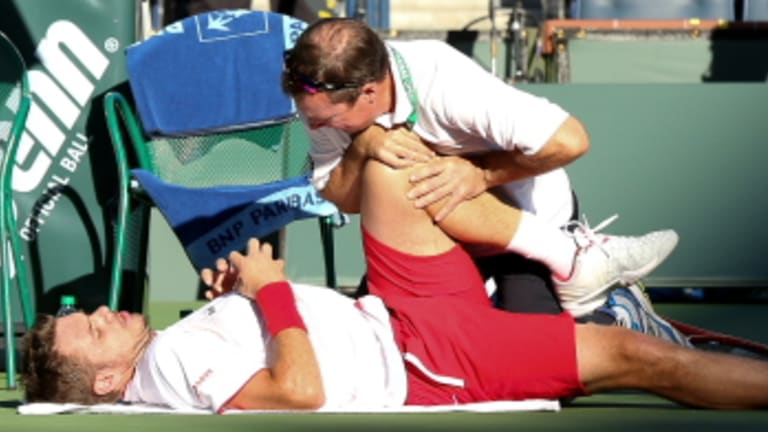INDIAN WELLS, CALIF.—When you're famous, they cheer differently for you. Stan Wawrinka, the world’s newest Grand Slam champion, rifled a forehand winner early in his fourth-round match against Kevin Anderson today and the fans went, “Oooh,” and “Ummm hmmm," as if this was what they expected to see from him. When he missed, they acted like they couldn’t believe it. “Oh, Stan!” a woman near me shrieked after he hit a forehand long on a break point. It sounded like she was rooting for her own son. A few points later, she offered a little motherly—or perhaps just womanly—support, American-style: “C’mon Stan, baby!”
With his win over Rafael Nadal in Melbourne, Wawrinka began to mean something to people, and to the game, that he hadn’t meant before. There’s a new connection with fans who were inspired by his Cinderella “fail better” story in Oz. A regular denizen of the outer courts here in the past, today Wawrinka was front and center on the stadium court, the anchor match in a day session that also included Roger Federer and Andy Murray.
More important, Stan now means something different to his opponents. They may also have been inspired by his breakthrough Down Under, but what they’re really motivated to do now is beat him. When you’re the favorite, the hunted, you play differently—you win differently. You go in knowing that your opponent has less to lose, and will probably attack with everything he’s got. Top players like Nadal and Pete Sampras have tended to bide their time and pounce on that one break of serve when they see the chance. They rely on their superiority, as well as their opponent’s nerves, in the clutch.
As the tight first set between Anderson and Wawrinka progressed, you could see that Stan would have to win it in just that way, by threading a narrow path through at the end. But he never found the path. Wawrinka had two break points at 4-4; Anderson erased one with an ace, and on the other Stan sent a makeable forehand long. In the tiebreaker, his back tightened up, and his game fell apart. When Wawrinka took a medical timeout and went down a break in the second, it looked like his day was over.
Then, for the first time, Wawrinka showed some of the reserve confidence we expect from our Grand Slam champions. With Anderson serving at 3-2, Wawrinka hit a backhand pass winner to break at love, and followed it with a love hold. Everything we saw in Australia still seemed to be intact: Wawrinka was showing more positive emotion, and striking when he saw the chance. Anderson, who double-faulted eight times, was getting a creaky elbow at the thought of beating him. Serving at 4-5, Anderson threw in two unforced errors and was broken. When the South African's last forehand sailed long, Wawrinka pumped his fist as if he had never left Melbourne.
But weren’t back in Oz anymore. Wawrinka walked back out and played a poor service game to open the third set. He was broken, and was never in it after that. By the end, Stan had unraveled completely; down match point at 1-5, he walked to the baseline with a ball in his mouth. The hunted had been caught. Anderson handed Wawrinka his first loss of 2014, 7-6 (1), 4-6, 6-1.
Afterward, Wawrinka refused to blame any physical issue.
